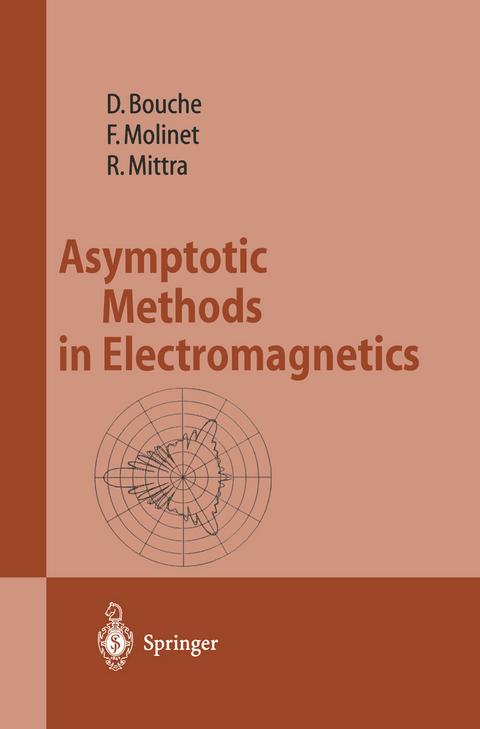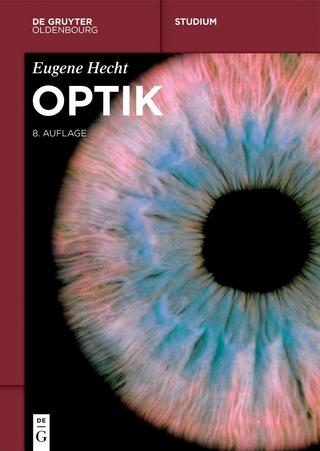
Asymptotic Methods in Electromagnetics
Springer Berlin (Verlag)
978-3-642-64440-5 (ISBN)
The book will help the reader to acquire both a working knowledge and a theoretical understanding of the different methods for solving electromagnetic scattering problems at high frequencies.
1. Ray Opties.- 1.1 Introduction.- 1.2 Ray tracing using generalized Fermat's principle.- 1.3 Calculation of the field along a ray.- 1.4 Calculation of the geometrical factors.- 1.5 Calculation of the diffraction coefficients.- 1.6 Some limitations of the ray method.- 1.7 Examples.- 1.8 Conclusions.- References.- 2. Search for Solutions in the Form of Asymptotic Expansions.- 2.1 Perturbation methods as applied to diffraction problems.- 2.2 Ray fields.- References.- 3. The Boundary Layer Method.- 3.1 Boundary layers of creeping rays on a cylindrical surface (Fig. 3.1).- 3.2 Boundary layers of creeping rays on a general surface.- 3.3 Boundary layer of the whispering gallery modes.- 3.4 Neighborhood of a regular point of a caustic (Fig. 3.11).- 3.5 Neighborhood of the light-shadow boundary.- 3.6 Boundary layer in the neighborhood of an edge of curved wedge (Fig. 3.13).- 3.7 Neighborhood of the contact point of a creeping ray on a smooth surface.- 3.8 Calculation of the field in the neighborhood of a point of the shadow boundary.- 3.9 Whispering gallery modes incidents upon an inflection point (Fig.3.16).- 3.10 Matching principle.- 3.11 Matching the solution expressed in the form of a creeping ray at the contact point.- 3.12 Matching of the solution in the boundary layer in the vicinity of surface to the solution in the form of creeping rays and determination of the solution in the shadow zone.- 3.13 Matching of the boundary layer in the neighborhood of the edge of a wedge.- 3.14 The case of caustics.- 3.15 Matching in the neighborhood of the contact point (Fig. 3.17).- References.- 4. Spectral Theory of Diffraction.- 4.1 Introduction.- 4.2 The Plane Wave Spectrum (PWS).- 4.3 Examples of plane wave spectral representation.- 4.4 Diffraction of complex fields diffraction- Case examples.- References.- 5. Uniform Solutions.- 5.1 Definition and properties of a uniform asymptotic expansion.- 5.2 Generalities on the research methods of a uniform solution.- 5.3 Uniform solutions through the shadow boundaries of the direct field and he field reflected by a wedge.- 5.4 UAT solution for a line discontinuity in the curvature.- 5.5 Uniform solution through the shadow boundary and the boundary layer of a regular convex surface.- 5.6 Partially- and totally-uniform solutions for a wedge with curved faces, including creeping rays.- 5.7 Uniform solutions for the saustics.- References.- 6. Integral methods.- 6.1 The Maslov method.- 6.2 Integration on a wavefront.- References.- 7. Surface Field and Physical Theory of Diffraction.- 7.1 Uniform field.- 7.2 Fringe field.- 7.3 The physical theory of diffraction.- 7.4 Generalizations of the PTD.- 7.5 PTD Application examples.- 7.6 Conclusions.- References.- 8. Calculation of the Surface Impedance, Generalization of the Notion of Surface Impedance.- 8.1 Mathematical foundations and determination of the surface impedance.- 8.2 Direct treatment of the material.- 8.3 Generalized surface impedance.- 8.4 Conclusions.- References.- Appendix 1. Canonical Problems.- A1.1 Reflection of a plane wave by a plane.- A1.2 Diffraction by a circular cylinder whose surface impedance is constant.- A1.2.1 General solution of the cylinder problem.- Al.3 Diffraction by a wedge.- References.- Appendix 2. Differential Geometry.- A2.1 Calculation of the ray lengths.- A2.2.1 Two-dimensional case.- A2.3 Geodesic coordinate system and applications.- A2.3.1 The geodesic coordinates.- A2.3.2 The surface in geodesic coordinates.- A2.4 Coordinate system of the lines of curvature.- Reference.- Appendix 3. Complex Rays.- A3.1 Complexsolutions of the eikonal equation, complex rays.- A3.2 Solution of the transport equations.- A3.3 Field calculation in real space.- A3.4 Calculation of the reflected field with the method of complex rays.- A3.5 Other applications of complex rays.- References.- Appendix 4. Asymptotic Expansion of Integrals.- A4.1 Evaluation of the contributions of isolated critical points.- A4.1.1 The method of the stationary phase.- A4.1.2 The method of steepest descent.- A4.1.3 Integration by parts.- A4.1.4 Limitations of the previous methods.- A4.2 Coalescence of critical points, uniform expansions points.- Reference.- Appendix 5. Fock Functions.- A5.1 Utilization of the Fock functions.- A5.2 Definition of the Fock functions.- A5.3 Asymptotic behaviors of Airy functions.- A5.7 Conclusions.- Reference.- Appendix 6. Reciprocity Principle 523.- Reference.
| Erscheint lt. Verlag | 18.9.2011 |
|---|---|
| Zusatzinfo | XXII, 526 p. |
| Verlagsort | Berlin |
| Sprache | englisch |
| Maße | 155 x 235 mm |
| Gewicht | 825 g |
| Themenwelt | Naturwissenschaften ► Physik / Astronomie ► Optik |
| Schlagworte | Analysis • Differential Geometry • Electromagnetic field • Geometry • Integral • Integration • scattering |
| ISBN-10 | 3-642-64440-6 / 3642644406 |
| ISBN-13 | 978-3-642-64440-5 / 9783642644405 |
| Zustand | Neuware |
| Haben Sie eine Frage zum Produkt? |
aus dem Bereich


